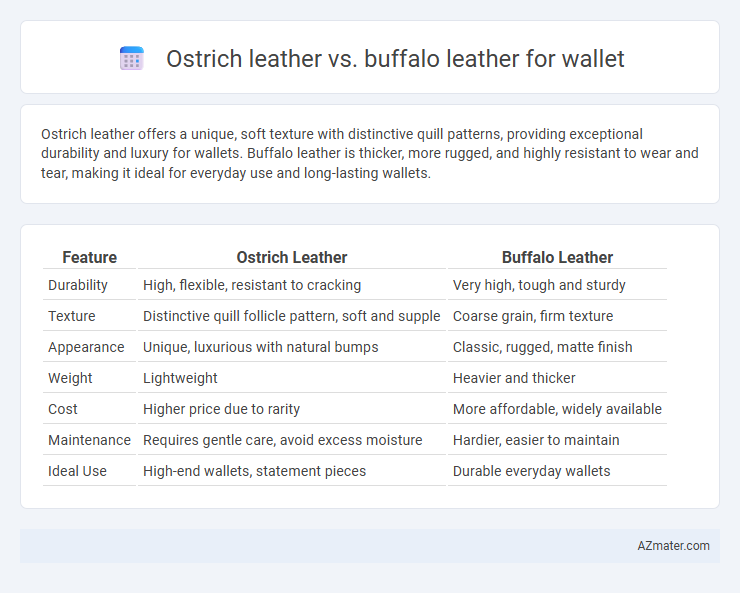Ostrich leather offers a unique, soft texture with distinctive quill patterns, providing exceptional durability and luxury for wallets. Buffalo leather is thicker, more rugged, and highly resistant to wear and tear, making it ideal for everyday use and long-lasting wallets.
Table of Comparison
| Feature | Ostrich Leather | Buffalo Leather |
|---|---|---|
| Durability | High, flexible, resistant to cracking | Very high, tough and sturdy |
| Texture | Distinctive quill follicle pattern, soft and supple | Coarse grain, firm texture |
| Appearance | Unique, luxurious with natural bumps | Classic, rugged, matte finish |
| Weight | Lightweight | Heavier and thicker |
| Cost | Higher price due to rarity | More affordable, widely available |
| Maintenance | Requires gentle care, avoid excess moisture | Hardier, easier to maintain |
| Ideal Use | High-end wallets, statement pieces | Durable everyday wallets |
Introduction to Exotic Leathers
Ostrich leather, prized for its distinctive quill pattern and exceptional softness, offers both durability and a unique aesthetic appeal in wallet craftsmanship. Buffalo leather provides a robust texture with natural grain variations, ensuring resilience and a rugged, masculine look in leather goods. Both exotic leathers stand out for their strength, longevity, and luxurious feel, making them popular choices for premium wallets.
Overview of Ostrich Leather
Ostrich leather is renowned for its distinctive quill follicle pattern, offering a unique texture and exceptional durability, making it a premium choice for wallets. It features high tensile strength and flexibility, providing resistance to wear and ensuring long-lasting use. Compared to buffalo leather, ostrich leather is more lightweight and supple, adding a luxurious feel while maintaining rugged resilience.
Overview of Buffalo Leather
Buffalo leather offers exceptional durability and a natural grain pattern that enhances the rugged aesthetic of wallets, making it ideal for everyday use. Known for its resistance to scratches and moisture, buffalo leather wallets maintain their shape and appearance longer than many other types of leather. This material is also prized for its thickness and strength, providing a robust alternative to ostrich leather, which is valued more for its unique texture and softness.
Durability: Ostrich vs Buffalo Leather
Ostrich leather is highly durable due to its unique quill follicle pattern, providing exceptional resistance to wear and tear while remaining soft and flexible. Buffalo leather offers superior toughness and natural resistance to scratches and abrasions, making it ideal for long-lasting wallets that endure rough use. When comparing durability, buffalo leather generally outperforms ostrich leather in terms of strength, though ostrich leather excels in flexibility and unique texture retention.
Texture and Appearance Differences
Ostrich leather features a distinctive quill pattern with raised bumps, giving wallets a unique, luxurious texture that is both soft and supple. Buffalo leather, in contrast, exhibits a more pronounced grain with natural wrinkles and a rugged appearance, offering durability and a rustic charm. The visual appeal of ostrich leather is highly sought after for its exotic look, while buffalo leather states a classic, robust style favored for everyday use.
Cost Comparison
Ostrich leather wallets typically cost significantly more than buffalo leather due to the rarity and unique texture of ostrich hide, with prices often ranging from $150 to $400. Buffalo leather wallets are more affordable, generally priced between $50 and $150, offering durability at a lower cost. The higher cost of ostrich leather reflects its distinctive quill pattern and softness, making it a premium choice compared to the thicker, more rugged buffalo leather.
Maintenance and Care Requirements
Ostrich leather requires moderate maintenance, benefiting from regular conditioning to prevent drying and cracking due to its porous texture and natural oils. Buffalo leather offers greater durability with less frequent care, typically needing only occasional cleaning and conditioning to maintain its rugged surface and resilience. Both leathers should be kept away from excessive moisture and direct sunlight to preserve their texture and longevity in wallet production.
Environmental Impact and Sourcing
Ostrich leather, sourced primarily from South Africa, is considered more sustainable due to the ostrich's efficient feed-to-growth ratio and the utilization of feathers and meat byproducts, reducing waste. Buffalo leather, often obtained from water buffalo farms in Asia, has a higher environmental footprint linked to land use, methane emissions, and water consumption in livestock farming. Both leathers are durable for wallets; however, ostrich leather's eco-friendly sourcing and lower resource demand contribute to a more sustainable choice in environmentally conscious leather goods.
Best Uses for Each Leather Type
Ostrich leather, known for its distinctive quill follicle pattern and superior softness, is ideal for luxury wallets that emphasize unique texture and aesthetic appeal. Buffalo leather offers exceptional durability and a rugged appearance, making it perfect for wallets designed for everyday use and long-lasting wear. Each leather type serves distinct purposes: ostrich leather suits high-end fashion items, while buffalo leather excels in practical, heavy-duty wallets.
Which Leather is Best for Wallets?
Ostrich leather boasts a distinctive quill pattern, exceptional softness, and high durability, making it ideal for premium wallets that combine luxury with resilience. Buffalo leather offers a robust texture, superior strength, and natural resistance to wear, providing wallets with long-lasting toughness and a rugged aesthetic. Choosing the best leather depends on the balance between elegance and durability desired, with ostrich leather favored for luxury and buffalo leather preferred for toughness.

Infographic: Ostrich leather vs Buffalo leather for Wallet
 azmater.com
azmater.com